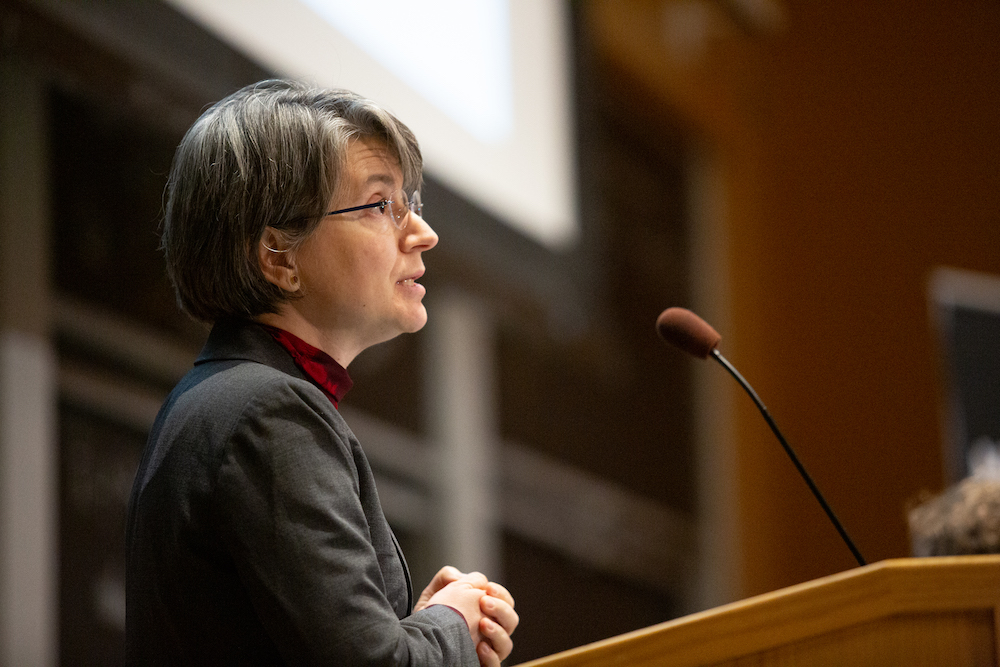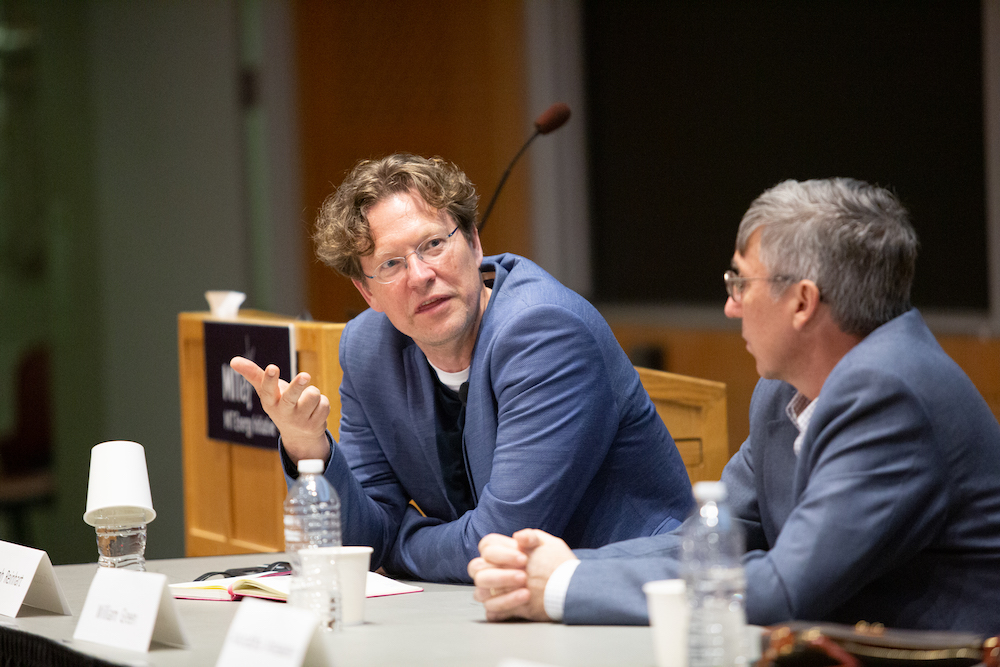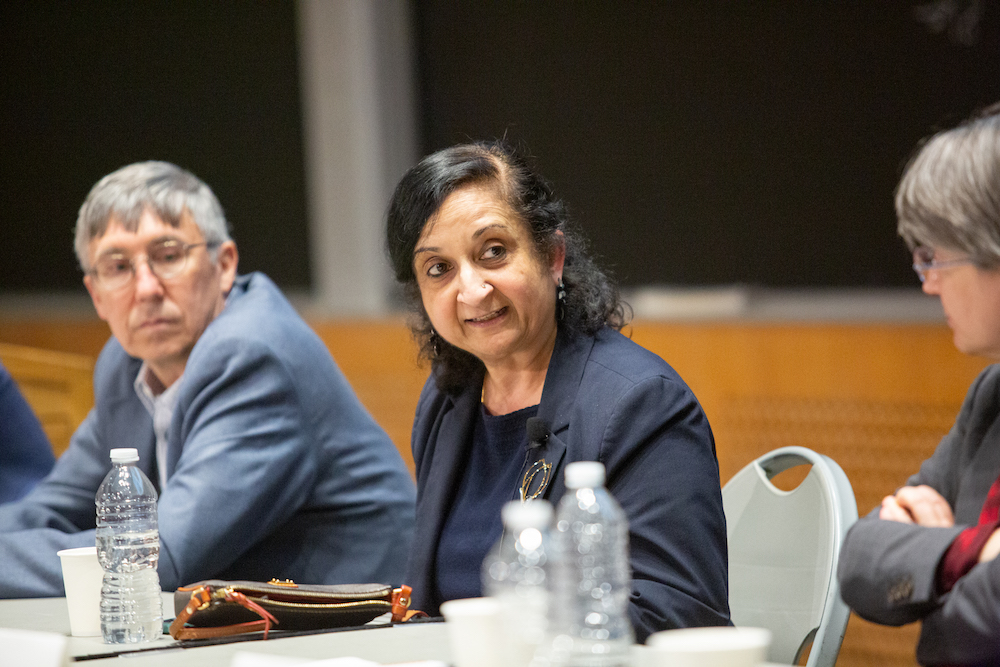
Five speakers at a recent public panel discussion hosted by the MIT Energy Initiative (MITEI) and introduced by Deputy Director for Science and Technology Robert Stoner, tackled one of the thorniest yet most critical questions facing the world today—how to achieve the ambitious goals set by governments around the globe, including the United States, to achieve net-zero emissions of greenhouse gases by mid-century?
While the challenges are great, the panelists agreed, there is reason for optimism that these technological challenges can be solved. More uncertain, some suggested, are the social, economic, and political hurdles to bringing about the needed innovations.
The speakers addressed areas where new or improved technologies or systems are needed if these ambitious goals are to be achieved. Anne White, MIT’s deputy provost and a professor of nuclear science and engineering, moderated the panel discussion. She said that achieving the ambitious net-zero goal “has to be accomplished by filling some gaps, and going after some opportunities.” In addressing some of these needs, she said the five topics chosen for the panel discussion were “places where MIT has significant expertise, and progress is already ongoing.”
First of these was the heating and cooling of buildings. Christoph Reinhart, a professor of architecture and director of the Building Technology Program, said that currently about 1% of existing buildings are being retrofitted each year for energy efficiency and conversion from fossil-fuel heating systems to efficient electric ones—but that is not nearly enough to meet the 2050 net-zero target. “It’s an enormous task,” he said. To meet the goals, he said, would require increasing the retrofitting rate to 5% per year, and to require all new construction to be carbon neutral as well.

Professor Christoph Reinhart discusses the impacts of retrofitting buildings for energy efficiency and conversion from fossil-fuel heating systems to efficient electric ones. Credit: Kelley Travers
Reinhart then showed a series of examples of how such conversions could take place using existing solar and heat pump technology, and depending on the configuration, how they could provide a payback to the homeowner within ten years or less. However, the initial cost outlay for such a system, on the order of $50,000, is likely to put conversions out of reach of many people without strong policy incentives. Still, a recent survey found that 30% of homeowners polled said they would accept installation at current costs. While there is government money available for incentives for others, “we have to be very clever on how we spend all this money… and make sure that everybody is basically benefitting.”
William Green, a professor of chemical engineering, spoke about the daunting challenge of bringing aviation to net zero. “More and more people like to travel,” he said, but that travel comes with carbon emissions that affect the climate, as well as air pollution that affects human health. The economic costs associated with these emissions, he said, are estimated at $860 per ton of jet fuel used—which is very close to the cost of the fuel itself. So the price paid by the airlines, and ultimately by the passengers, “is only about half of the true cost to society, and the other half is being borne by all of us, by the fact that it’s affecting the climate and it’s causing medical problems for people.”
Eliminating those emissions is a major challenge, he said. Virtually all jet fuel today is fossil fuel, but airlines are starting to incorporate some biomass-based fuel, derived mostly from food waste. But even these fuels are not carbon-neutral, he said. “They actually have pretty significant carbon intensity.”
But there are possible alternatives, he said, mostly based on using hydrogen produced by clean electricity, and making fuels out of that hydrogen by reacting it, for example, with carbon dioxide. This could indeed produce a carbon-neutral fuel that existing aircraft could use, but the process is costly, requiring a great deal of hydrogen, and ways of concentrating carbon dioxide. Other viable options also exist, but all would add significant expense, at least with present technology. “It’s going to cost a lot more for the passengers on the plane,” Green said, “But the society will benefit from that.”
Increased electrification of heating and transportation in order to avoid the use of fossil fuels will place major demands on the existing electric grid systems, which have to perform a constant delicate balancing of production with demand. Anuradha Annaswamy, a senior research scientist in MIT’s mechanical engineering department, said “the electric grid is an engineering marvel.” In the United States it consists of 300,000 miles of transmission lines capable of carrying 470,000 megawatts of power.

During MITEI’s panel on energy innovation for a net-zero future, Senior Research Scientist Anuradha Annaswamy (center) and the other speakers address areas where new or improved technologies or systems are needed to achieve global net-zero emissions goals. Credit: Kelley Travers
But with a projected doubling of energy from renewable sources entering the grid by 2030, and with a push to electrify everything possible—from transportation to buildings to industry—the load is not only increasing, but the patterns of both energy use and production are changing. Annaswamy said that “with all these new assets and decision makers entering the picture, the question is how you can use a more sophisticated information layer that coordinates how all these assets are either consuming or producing or storing energy, and have that information layer coexist with the physical layer to make and deliver electricity in all these ways. It’s really not a simple problem.”
But there are ways of addressing these complexities. “Certainly, emerging technologies in power electronics and control and communication can be leveraged,” she said. But she added that “This is not just a technology problem, really it is something that requires technologists, economists, and policy makers to all come together.”
As for industrial processes, Bilge Yildiz, a professor of nuclear science and engineering and materials science and engineering, said that “the synthesis of industrial chemicals and materials constitutes about 33% of global CO2 emissions at present, and so our goal is to decarbonize this difficult sector.” About half of all these industrial emissions come from the production of just four materials: steel, cement, ammonia, and ethylene, so there is a major focus of research on ways to reduce their emissions.
Most of the processes to make these materials have changed little for more than a century, she said, and they are mostly heat-based processes that involve burning a lot of fossil fuel. But the heat can instead be provided from renewable electricity, which can also be used to drive electrochemical reactions in some cases as a substitute for the thermal reactions. Already, there are processes for making cement and steel that produce only about half the present CO2 emissions.
The production of ammonia, which is widely used in fertilizer and other bulk chemicals, accounts for more greenhouse gas emissions than any other industrial source. The present thermochemical process could be replaced by an electrochemical process, she said. Similarly, the production of ethylene, as a feedstock for plastics and other materials, is the second-highest emissions producer, with 3 tons of CO2 released for every ton of ethylene produced. Again, an electrochemical alternative method exists, but needs to be improved to be cost competitive.
As the world moves toward electrification of industrial processes to eliminate fossil fuels, the need for emissions-free sources of electricity will continue to increase. One very promising potential addition to the range of carbon-free generation sources is fusion, a field in which MIT is a leader in developing a particularly promising technology that takes advantage of the unique properties of high temperature superconducting (HTS) materials.
Dennis Whyte, the director of MIT’s Plasma Science and Fusion Center, pointed out that despite global efforts to reduce CO2 emissions, “we use exactly the same percentage of carbon-based products to generate energy as ten years ago, or 20 years ago.” To make a real difference in global emissions, “we need to make really massive amounts of carbon-free energy.”
Fusion, the process that powers the sun, is a particularly promising pathway, because the fuel, derived from water, is virtually inexhaustible. By using recently developed HTS material to generate the powerful magnetic fields needed to produce a sustained fusion reaction, the MIT-led project, which led to a spinoff company called Commonwealth Fusion Systems, was able to radically reduce the required size of a fusion reactor, Whyte explained. Using this approach, the company, in collaboration with MIT, expects to have a fusion system that produces net energy by the middle of this decade, and be ready to build a commercial plant to produce power for the grid early in the next. Meanwhile, at least 25 other private companies are also attempting to commercialize fusion technology. “I think we can take some credit for helping to spawn what is essentially now a new industry in the United States,” Whyte said.
Fusion offers the potential, along with existing solar and wind technologies, to provide the emissions-free power the world needs, Whyte says, but that’s only half the problem, the other part being how to get that power to where it’s needed, when it’s needed. “How do we adapt these new energy sources to be as compatible as possible with everything that we have already in terms of energy delivery?”
Part of the way to find answers to that, he suggested, is more collaborative work on these issues that cut across disciplines, as well as more of the kinds of cross-cutting conversations and interactions that took place in this panel discussion.